California Gold Quartz Veins
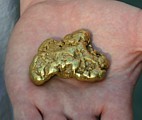
.
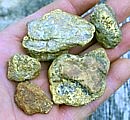
|
 |
||
|
. |
Want to learn about the formation of the gold bearing quartz veins of California? The state of California has produced a lot of gold over the years and still holds quite a few gold deposits - its no accident its called the golden state. The state has long been famous for high grade pockets of gold quartz with visible native gold. From the mother lode to the Klamath Range all the way down to the southeastern deserts, the state is rich with the precious yellow metal. Take a look at the following information........ |
 |
|
|
Veins of gold bearing quartz are well known in California, and historically they have produced millions of dollars worth of gold. Their formation and the gold they contain are of interest. Quartz mines are found and worked in a great many counties in California, from Siskiyou on the north to San Diego on the south. Most of these are in the mountain, foot-hill and desert regions, there being none of note in the valley counties and very few in the Coast Ranges. Most are mesothernal in origin, and they are often described as segregated veins, emplaced in schist, slates or metamorphosed igneous rocks (greenstone), and more or less parallel with the schistosity of these rocks. Less commonly the walls are massive, igneous rocks. The quartz contains auriferous pyrite, free gold, arsenopyrite, chalcopyrite, tetrahedrite, galena, and sphalerite, but pyrite is far the most abundant. Tellurides such as calaverite and sylvanite have been occasionally detected in small amounts and locally other rare minerals such as scheelite, native bismuth, pitchblende, tetrahedrite, stibnite, molybdenite and fluorite are also occasionally found. Productive quartz is grayish or bluish in many instances because of the presence of fine-grained sulfides. The veins approximate at times a lenticular shape, which is less marked in California than in some other regions, and which shows analogies of shape with pyrites lenses and magnetite lenses In such cases the fissure-vein character is somewhat obscure. In California the veins occupy previously existing fissures in the slates. The largest and best known is the so called Mother Lode, which is a lineal succession of innumerable larger and smaller quartz veins that run parallel with the strike, and rarely cut the steep dip of the slates at an angle of 10 degrees. It was doubtless formed by faulting along the Melones fault zone in steeply dipping strata. The veins are persistent along regional high-angle faults, joint sets. The best deposits overall form in in areas where greenstone / greenschist rocks (metavolcanics) are present. High-grade ore shoots form locally at or near metasediment-serpentine contacts. The wall rocks of the California veins embrace many types of igneous rocks, as well as sedimentary slates, for all these enter into the western slopes of the Sierras. The dominant type however, are meta-sedimentary rocks of one type or another. The frequent serpentine is a metamorphosed igneous rock, while the diabase and diorite form great dikes. Considerable calcite, dolomite, and ankerite occur with the quartz, and very often it is penetrated by seams of a green, chloritic silicate, which was provisionally called mariposite, but which has been shown by Turner to be a potassium mica, colored green by chromium. Altered wall rocks frequently show the presence of Quartz, siderite, and (or) ankerite and albite in veins with halo of carbonate alteration further out. Green Chrome bearing mica with dolomite and talc as well as siderite are found in areas where ultramafic rocks are present. |
||
|
The quartz veins vary somewhat in appearance, being at times milk white and massive (locally called "hungry," from its general barrenness), at times greasy and darker, and again manifesting other differences, which are difficult to describe, although more or less evident in specimens. The richer quartz in many mines is somewhat banded, and is called ribbon quartz. The quartz has been studied in thin sections, especially in rich specimens, by W. M. Courtis, who shows that fluid or gaseous inclusions of what is probably carbonic acid are abundant. In rich specimens the cavities tend to be more numerous than in poor, but more data are needed to form the basis of any reliable deductions. Some quartz shows evidence of dynamic disturbances. The walls of the veins are themselves at times impregnated with the precious metal and the attendant sulphides. The rich portions of the veins occur in chutes which run diagonally down on the dip. The so-called "auriferous slate belt" of California, of which the Mother Lode is only one part, begins south of Mariposa County and extends north-westerly along the western flank of the Sierra Nevada to the north line of Plumas county, and doubtless farther, but beyond that point it is covered with vast sheets of barren lava. As described, it is about 250 miles long and twenty to seventy miles wide, and forms about one-third of the precious mineral-bearing area of the State, but it is so far the most productive part. The general strike of the strata is north-westerly, which is parallel with the axis of the Sierra Nevada and they dip very steeply to the north-east. Within this area are a countless number of gold-bearing quartz veins, commonly following the strike and dip of the strata, occasionally crossing them.
|
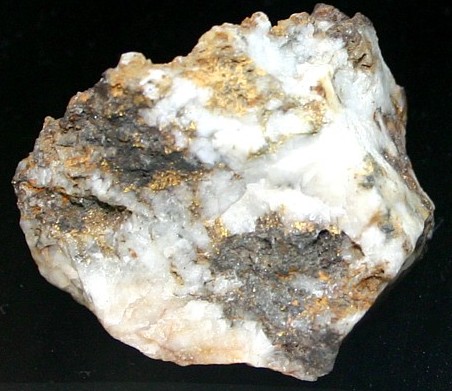 Rich Gold Bearing Quartz from the Mother Lode of California |
|
|
The great Mother Lode vein system is the largest group of veins in California. It extends 112 miles in a general northwest direction. Beginning in Mariposa County, in the south, it crosses Tuolumne, Calaveras, Amador, and El Dorado counties in succession. It is not strictly continuous nor is it one single lode, but rather a succession of related ones, which branch, pinch out, run off in stringers, and are thus complex in their general grouping. It parallels the axis of the range and the general trend of the formations. Many veins of this group strike about N. 25 W and dip about 60 E. Single deposits are developed for more than a mile along the strike. Over 500 patented locations have been made on it. The mother lode counties furnished a large percentage of the milling ores of the State. The average recovery per ton is much less than in other counties where the veins are smaller and richer. The average recovery from all the counties in the Mother Lode district is less than $4 per ton while in Nevada County the amount exceeds $10 in gold and silver per ton of ore mined. One characteristic of the Mother Lode is the permanancy of the ore with increasing depth. In Amador County the mines are over 5000 ft. deep on the dip and the ore is as good as that found at the surface. The ores occur in fissure veins in steeply dipping slates and altered volcanics of Carboniferous and Jurassic age. The ores are found at so great a distance from the granitic rocks of the Sierra Nevada range that they are supposed to bear no genetic relation to them. The veins occur both in the slates and at their contact with diabase dikes. The veins show a remarkable extent and uniformity. The veins are often left in strong relief by the erosion of the wall rock, and thus are called ledges, or reefs. In the tilted layers of the slate there lay planes of weakness which the mineral-bearing solutions followed. The chief gangue mineral is quartz, and the ore is native gold and auriferous pyrite. |
||
|
As a rule the Mother Lode deposits are large but of comparatively low grade, the average tenor being about $4 a ton. Some mines exploit large bodies of ore that carry, less than $3 a ton, but pockets of very rich ore concentrations have also been found. The principal gangue minerals are quartz, calcite, siderite and other carbonates, as well as albite feldspar. As a rule the gold is associated with sulphides, including pyrite, arsenopyrite, and pyrrhotite, with pyrite, chalcopyrite, and galena. Specularite, magnetite, tetrahedrite, molybdenite, telluride, and scheelite occur also, but only locally. Overall, the sulphides constitute only a very small percentage of the total ore volume. By mechanical concentration in milling prior to cyanide treatment, deposits of very low grade are still profitably worked. The silver content of these ores is small in most of the deposits. The remarkable persistence of the Mother Lode gold ores in great depth points to ascending watery solutions as the agents of vein deposition, and the geographic relations of the deposits to intruding igneous rocks suggest a close genetic relation between the igneous rocks of the Sierra Nevada and the ore-depositing solutions. This is consistent with the fact that the faults along which they are emplaced are deep. The Mother Lode fault and joint systems are produced by regional tectonic compression and are located at the accreted continental margin. |
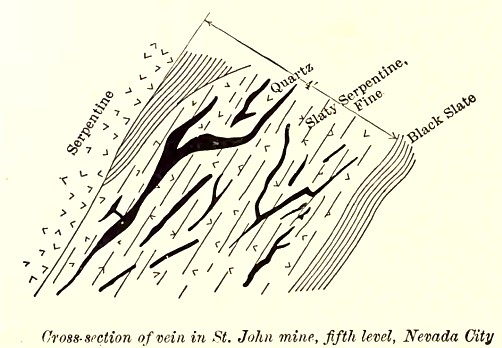 |
|
|
The Grass Valley district of Nevada County, while not a part of the mother lode belt, was the leading quartz-mining section of the State. None of the other counties, even those of the famous Mother Lode, approach it in Nevada County in the production of gold. The deep mines of this county each year for many decades yielded about 2,000,000 tons of free milling ores and 500,000 tons of auriferous copper ores that were treated at the smelters. The veins are quartz and occur along the contact between a grano-diorite and diabase prophyry. They also cut the igneous rocks. Two systems of fissuring are known. The gold is either native or associated with metallic sulphides. The width of the vein seldom exceeds 3 ft. The lode ore occurs in well-defined bodies or pay shoots. W. Lindgren believes that the ores were leached out of the rock at a considerable depth and deposited by hot solutions while the wall rocks contained the rare metals in a disseminated condition. |
||
| . | ||
|
The California veins are younger than the igneous rocks with which they are associated. Granite and grano-diorite are especially frequent, but diorite, gabbro, diabase, porphyrite and serpentine, presumably derived from some basic intrusion, are also met. Although Von Richthofen stated that the veins seldom occur far from granite, this has been shown by Lindgren to be unjustified. The greater number are in slates, and the richest in a particular series of slates, but they also cut all manner of igneous rocks and have no constancy of direction. The California gold quartz type is in characteristic examples sufficiently pronounced to justify its special treatment. In fact, they are considered as a archetype of the low sulfide gold-quartz vein model. Other famous examples of this same type are found in the Ballarat Goldfields of Victoria, Australia and the Goldfields of Nova Scotia. Some discussion has arisen over the condition of the gold in the pyrite of the California quartz veins, but in most cases it is the native metal diffused through the pyrite crystal in tiny particles, and not an isomorphous sulphide. It has been detected in the metallic state, in a thin section of a pyrite crystal from Douglass Island, Alaska, and the fact that it remains as the metal when the pyrite is dissolved in nitric acid makes this undoubtedly the general condition. The association of gold with bismuth, which has been shown by R. Pearce to occur in the sulphurets of Gilpin County, Colorado, and the difficulty experienced in amalgamating some ores, indicate the possibility of other combinations. When crystallized, gold has shown, in one specimen and another, nearly all the forms of the isometric system, but the octahedron and rhombic dodecahedron are commonest. |
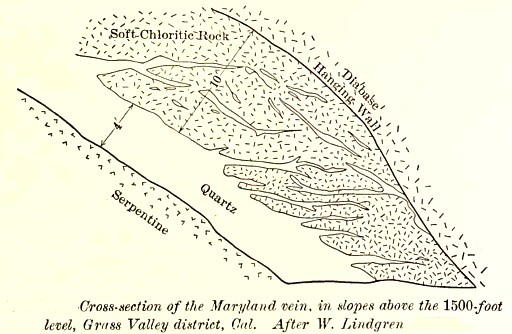 |
|
|
While igneous dikes often form one wall and slate the other, the source of the ore has been placed by most geologists as deep-seated locations, from whence the uprising solutions have brought the vein material and mineralization. The presence of igneous rocks nearby indicates elevated thermal conditions at depth, which have stimulated mineral bearing circulations, the veins being the filling of actual cavities. As a rule, the California veins are not much broader than two or three feet, although a network of small veins and even solid quartz may extend over a much greater width, and the gold may to a considerable degree impregnate the wall-rock. In the case of a considerable width of pure quartz, say 20 or 30 feet, an original cavity of this size is thought improbable, and this type of concept is consider as evidence that the growth of the veins forces out and open the fault fissure in which it grows. That some gold bearing ore bodies appear as is if they have been deposited by replacement, but this is not the case for the California quartz veins. The Diadem lode, southwest of Meadow Valley, in Plumas County, appears to be a bed of limestone or dolomite chiefly replaced by gold-bearing quartz and chalcedony, but in such a way that fossil foraminifera are still identifiable in the ore. However, Lindgren has acutely remarked that siliceous replacements exhibit either a very fine-grained aggregate of minute quartz crystals or else chalcedony, both quite different from the coarsely crystalline quartz of the typical quartz veins. In rare instances the gold is associated with some other gangue than quartz. Carbonates such as calcite, dolomite and siderite can be abundant. Thus G. F. Becker records gold in calcite, in the Mad Ox mine of Shasta County, where the hanging wall is a siliceous limestone. J. S. Diller has cited a similar case from Minersville, Trinity County. The gold occurred in veinlets of calcite in a dark, carbonaceous shale. Waldemar Lindgren has described an instance in which gold with some silver occurred in seams of barite, which were formed themselves in a kaolinized zone in diabase and diabase-porphyrite. The barite may have been derived from the feldspar of the original diabase. |
||
|
Lindgren has also written of most remarkable veins at Meadow Lake in Nevada County, that contain auriferous sulphides and arsenides in a gangue of tourmaline, quartz and epidote in granitic and diabasic rocks. This aggregate suggests fumarolic action. Similar associations of gold with tourmaline have been met in the Zoutpansberg District, South Africa, and in Brazil. The ores from the Shaw mine, El Dorado County, which have been donated to the School of Mines, at Columbia University. The mine is based on a dike of porphyrite, sixty or seventy feet thick and charged with pyrites. It is auriferous throughout, but richest next the walls. The gold in the native form occurs in veinlets of albite, which ramify through the porphyrite. An analysis by Mr. Hillebrand established the identity of the albite. The same samples had been previously studied by HW Turner of the U. S. Geol. Survey, by whom the determinations were originally made. Rickard has called attention to the especial abundance of gold at the intersection of small quartz veins in Tuolumne and Calaveras counties, California, and to the occurrence of a particularly rich pocket in the Rathgeb mine, San Andreas, where a small vein was faulted a few inches, and where the gold was associated with pitch-blende or unraninite and uranium ochre." W. H. Storms describes the Alvord mine in San Bernardino County where the gold occurs with a siliceous limonite in chutes in a belt of limestone. Storms in the citations given below records a great variety of wall rocks in which the veins occur, as well as interesting mineralogical details. |
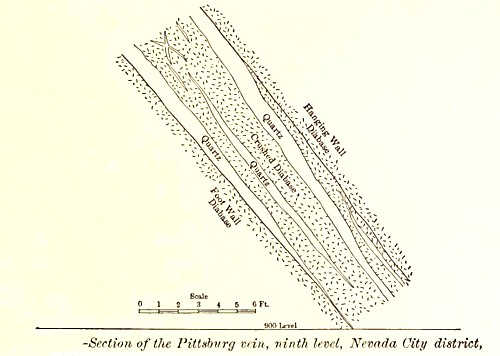 |
|
|
The formation of much the greater number of the veins followed the intrusion of the grano-diorite, which occurred at the close of the Jurassic or in early Cretaceous time. Some, however, may have existed before this, as is shown by Lindgren's interpretation of the Jurassic, auriferous conglomerate earlier cited, and a great series of veins certainly followed the Tertiary igneous outbreaks in the high Sierras. It seems quite indisputable, as advocated by Lindgren, that the gold and its associated minerals, including the quartz gangue came up in heated alkaline solution, and that the vein formation was attended by extended carbonatization of the walls. The deposition of the silica had slight chemical effect on the wall rock in other respects, for the change of the latter to carbonates is the chief alteration visible. The enormous introduction of silica is one of the most extraordinary features of the geology of the Sierras, and indicates a remarkable activity of circulating waters. The igneous intrusions
doubtless promoted, if they did not cause, the circulations that led to the
formation of these gold quartz veins. While the gold
is often entangled in pyrite, and while it appears to have been associated
with this iron compound in its precipitation, yet it also seems to have
certain to have been precipitated in the native state in essentially all instances.
Placer gold is usually of higher grade than
that obtained from quartz.
During prospecting, auriferous quartz lodes are often found by accident. Not infrequently it
happens that a rich streak of pay-dirt in a placer claim is followed up to
the quartz vein from which it came. While miners are out walking or hunting,
they occasionally will come upon lodes in which the gold is seen sparkling.
Some good leads have been found by men employed in making roads and cutting
ditches. The quartz might be covered with soil, but the pick and shovel
revealed its position and wealth. In Tuolumne county in 1858, a hunter shot
a grizzly bear on the side of a steep canon, and the animal tumbling down,
was caught by a projecting point of rock. The hunter followed his game, and
while skinning the animal, discovered that the point of rock was gold
bearing quartz. In Mariposa county, in 1855, a robber attacked a miner, and
the latter saw the rock behind his assailant sparkle in the sunlight, at a
spot where a bullet struck a wall of rock. He killed the robber, and found
that the rock was gold-bearing quartz. In Nevada county, many years ago, a
couple of unfortunate miners who had prepared to leave California, and were
out on a drunken frolic, started a large boulder down a steep hill. On its
way down, it struck a brown rock and broke a portion of it off exposing a
vein of white quartz which proved to be auriferous, induced the disappointed
miners to remain some months longer in the state, and paid them well for
remaining. Still this sort of discovery continues - in the 1990s, a hunter
found a large rich chunk of gold bearing quartz near Sierra City. |
||
| . | ||
Interested in seeing more gold? Here are some interesting photos of beautiful GOLD NUGGETS There is a second page of beautiful nugget photos: GOLD AND PLATINUM NUGGETS I also have a page of beautiful Silver Ore Specimen photos: SILVER ORES AND MINERALS and a page of beautiful Gold Ore Specimen photos: GOLD ORES AND MINERALS Want to know a little bit more about this crazy prospector guy? Well, here's a little bit more about me, and how I got into prospecting: Chris' Prospecting Story